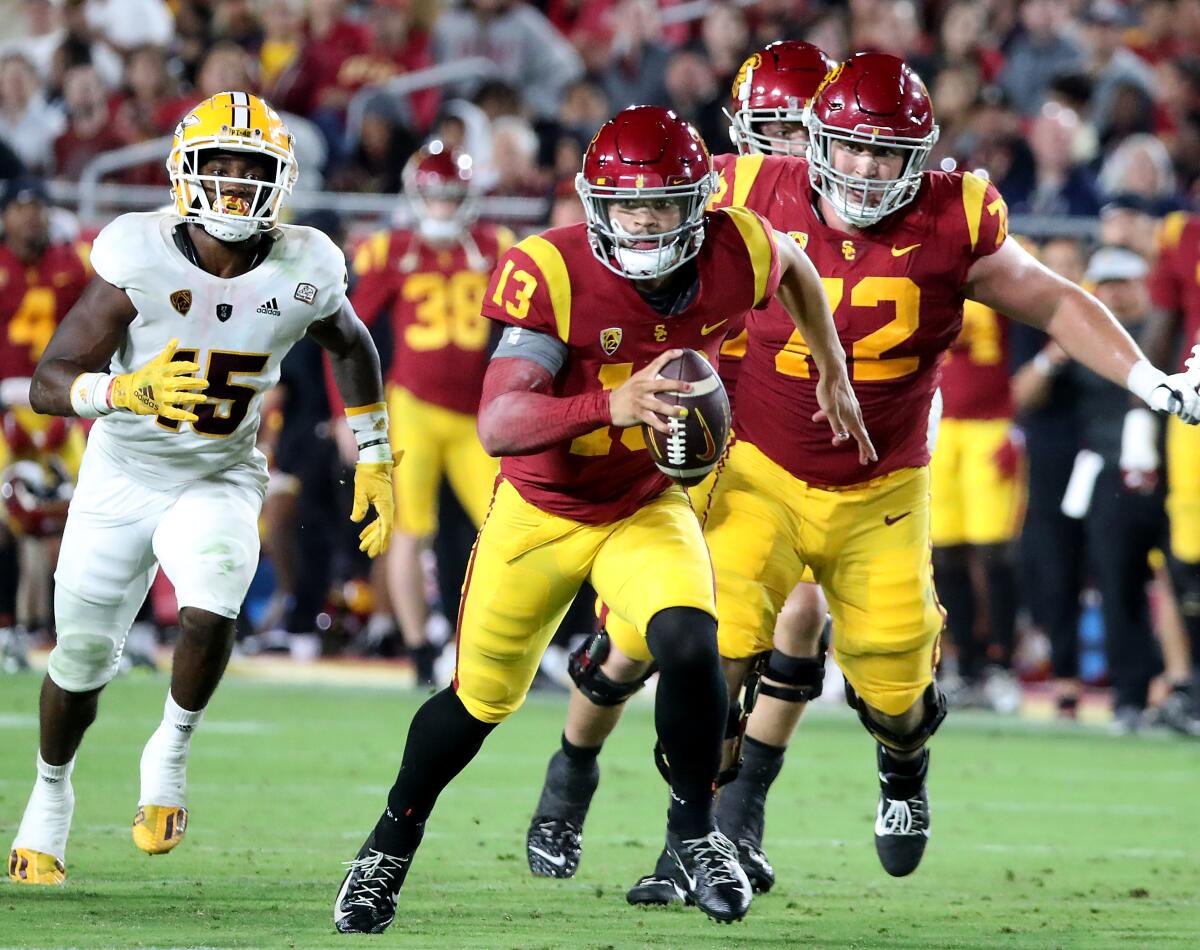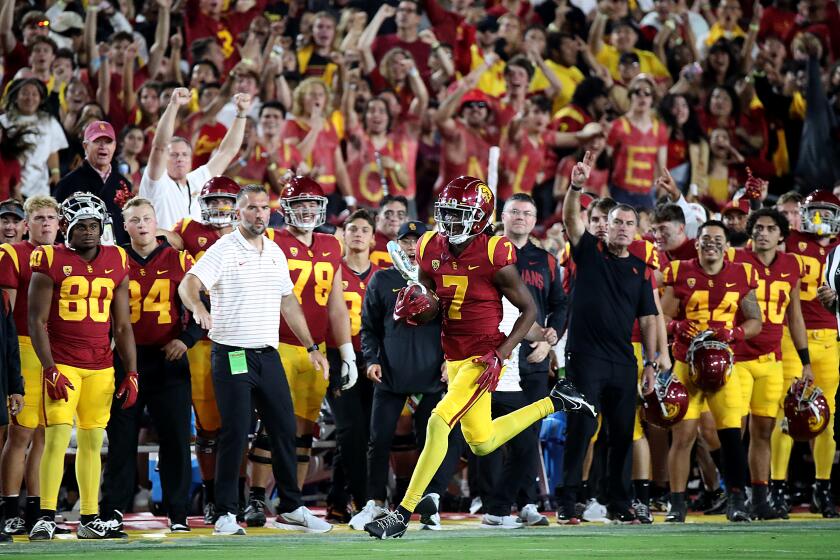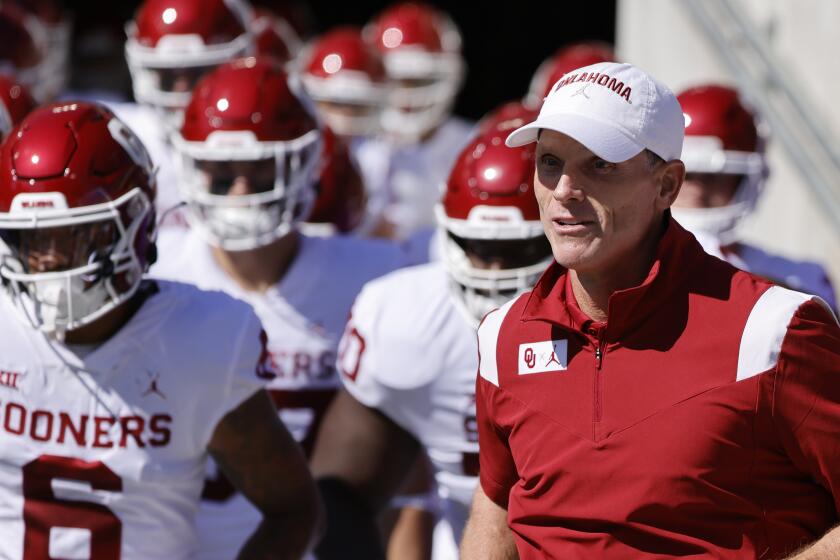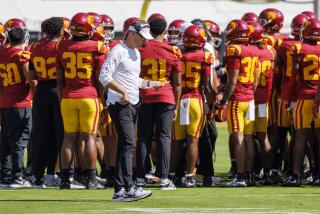USC offensive line vows to improve after leaving Caleb Williams scrambling

- Share via
When Josh Henson first took stock of USC’s offensive line last spring, the new offensive coordinator made note of what he thought was the Trojans’ most glaring need up front.
“We need to develop depth,” Henson said in March. “I think that’s what our challenge is this spring, to develop depth behind that first group and to get some guys closer to the first group so they can go compete. The best lines I’ve been in, we’ve had eight or nine guys that could play.”
Six months later, that depth suddenly faced its stiffest challenge yet, as redshirt junior reserve Gino Quinones stepped in at right guard last Saturday in place of injured team captain Justin Dedich, with fewer than two dozen snaps of experience.
Quinones hadn’t played a snap on the offensive line during his three previous seasons. Now he was being thrust into 70 snaps against one of the Pac-12’s stoutest interiors. It was a tall order.
USC coach Lincoln Riley called it “a big deal.”
“I thought he fought really hard and held his own for the most part,” right tackle Jonah Monheim added. “I was really proud of him.”
USC coach Lincoln Riley told his team at halftime, ‘We’re not playing like the Trojans,’ inspiring a dominant third quarter against Arizona State.
But with two of the Pac-12’s top defenses on tap during the next two weeks, the tests only get tougher.
Washington State, in particular, could pose a significant challenge to an offensive line that might not be at full strength by Saturday. The Cougars rank third nationally in tackles for a loss (44) and seventh in sacks (18), and in linebacker Daiyan Henley, they have one of the nation’s most disruptive defenders. Henley leads the Pac-12 in the former category (9.5 tackles for loss) — and ranks third in the latter (four sacks) — as the ball-stopping force at the center of a suddenly ferocious front.
“Your mistakes are going to be TFLs [tackles for a loss] against these guys,” Riley said.
It’s the kind of matchup that calls for a calming presence like Dedich to be in place, if possible. But whether USC will have to face that front without its captain was still uncertain as of Tuesday. Dedich was limited at practice, and Riley remained non-committal about his status.
“He’s better,” Riley said of USC’s starting right guard. “It was good that we were able to hold him. Where that leaves us, we’ll see. We’ll keep evaluating him throughout the week. We’re trying to be smart. Obviously, we’d love for him to be able to play, but the flip side of it is we’ve got a lot of the season left and you’ve got to be smart with them.”

USC has already weathered one absence up front, as left tackle Courtland Ford didn’t play against Fresno State or Oregon State while recovering from an ankle injury. Ford played only sparingly last Saturday, after a holding call negated an 82-yard Mario Williams touchdown. USC turned instead to its other experienced left tackle, Bobby Haskins, for the second half.
The decision to continue with Haskins, Riley clarified, was not a punishment for Ford. It could, however, be a sign of where USC is leaning at left tackle. Riley, through five weeks, has yet to name a starter.
“Courtland’s played a lot and is a good player,” Riley said. “He’s getting healthier and better and better as he gets back. So he’ll continue to be a big part of it.”
Quinones is certain to play a part, as well. Among an unproven group of reserve linemen, he’s been regularly praised for his progress since spring, when Henson first wondered aloud about USC’s depth. Riley also singled out tackle Mason Murphy, center Andrew Milek and guard Cooper Lovelace, each of whom could be called upon at some point this season.
Five weeks into the season, it’s time to grade the first-year college football coaches. Lincoln Riley and USC are among the big winners.
“Some of those guys are really getting better and improving,” Riley said. “So yeah, I think we’re in a good direction.”
Still, Dedich’s absence loomed large last Saturday, as USC’s shorthanded offensive line had its most disappointing performance to date. Caleb Williams was under constant pressure by Arizona State’s defense, forced to make daring escapes from the pocket, while USC’s rushing attack managed a meager 137 yards, its lowest total of the season.
Until that point, the offensive line had largely been a strength of USC’s offense. But last week, the group struggled to communicate, leading to mistakes, center Brett Neilon said. “Sometimes, it got sloppy.”
If Dedich is unable to play, that communication will be put to the test once again this weekend.
“We’ll get it fixed,” Neilon said.
More to Read
Go beyond the scoreboard
Get the latest on L.A.'s teams in the daily Sports Report newsletter.
You may occasionally receive promotional content from the Los Angeles Times.









